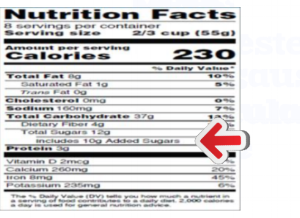The New Nutrition Label
Say goodbye to the standard nutrition label as you know it because starting on July 26, 2018 large food manufacturers will be required by law to change the nutrition label on their products. The new nutrition label will be an updated version focused on the new scientific information and forming a consumer-based label to provide the nutrition facts that many Americans really need. The new label will have many new features with different information as well as a different aesthetic.
The goal of this label is to provide consumers with more useful nutrition information that is scientifically valid while also emphasizing certain features of the food item such as calories and serving size. This will allow consumers to make more well-informed decisions to help improve overall health and reduce chronic disease risk through their diet.
The Changes:
1. Updated Serving Sizes:
This may be one of the most important changes to the nutrition label. The old nutrition label commonly uses tiny serving sizes in order to lower the caloric listing on the food label and make the food look healthier. The new law will force manufacturers to use serving sizes on the label that actually represent normal amounts that people commonly consume. This change will hopefully prevent many people from unknowingly over-consuming calories based on deceptive serving sizes.
2. Dual Column Labeling:
Not Only will labels be required to reflect serving size changes, they will also be required to have the nutritional content for the entire package on the label as a dual-column label.
3. Larger "Calories" Font:
This one is meant to emphasize caloric content of the product to make the consumer more aware of their caloric consumption.
4. Updated Daily Value %:
Due to new dietary guidelines, the daily value percentages of certain vitamins and minerals on food labels will be updated to reflect these changes.
5. Added Sugars:
Another extremely important change that reflects current scientific evidence is the requirement that "added sugars" must be a part of the new nutrition label. This change reflects the more recent evidence about the negative health consequences attributed to refined and added sugars.
6. Specific Vitamin and Mineral Changes:
Different vitamins and minerals will be required on labels while other ones will no longer be required. Vitamin A and Vitamin C will no longer be required on nutritional labels. The required vitamins include Vitamin D (new), Potassium (new), Calcium, and Iron.
7. "Calories from Fat" No Longer Permitted:
This change is one of the most important and does an excellent job of reflecting the most current research. More recently, the nutritional evidence is shifting away from low-fat diets and more toward a balanced approach (or even low-carbohydrate for weight loss). By no longer allowing "calories from fat" on nutritional labels, hopefully American's fear of fats will diminish and people will realize that fat is an essential part of a healthy diet.
Overall you should expect to see a lot of changes to the nutrition label in July 2018. These changes are important for not only the health-conscious consumer but also the average American who may be looking to cut out calories. Hopefully these changes are a sign of what is to come for the advancement of the US nutritional guidelines and how they reflect the current scientific evidence.








